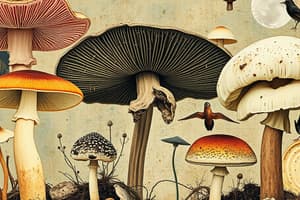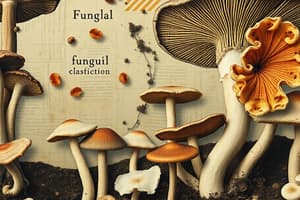Podcast
Questions and Answers
Why did the classification of fungi change?
Why did the classification of fungi change?
Scientists discovered that fungi are heterotrophs which means they get their nutrition from dead or decaying organisms in their environment, and that they do not have chloroplasts like plants do.
Into which of the three domains should a multicellular organism with a nucleus that breaks down decaying organisms be classified?
Into which of the three domains should a multicellular organism with a nucleus that breaks down decaying organisms be classified?
- Protists
- Eukarya (correct)
- Archaea
- Bacteria
What cell part do living things have that is used to classify them into the Eukarya domain?
What cell part do living things have that is used to classify them into the Eukarya domain?
Nucleus
What is the most important characteristic that biologists use to classify animals?
What is the most important characteristic that biologists use to classify animals?
In which kingdom would a new organism that is multicellular, does not carry out photosynthesis, and absorbs nutrients be classified?
In which kingdom would a new organism that is multicellular, does not carry out photosynthesis, and absorbs nutrients be classified?
What is the most important factor to know in order to classify a new organism into a kingdom?
What is the most important factor to know in order to classify a new organism into a kingdom?
What would most likely change the current classification of two closely related flower species to a single species?
What would most likely change the current classification of two closely related flower species to a single species?
What are the classification levels that make up an organism's scientific name?
What are the classification levels that make up an organism's scientific name?
Which scientific tool would aid scientists in determining how closely related two organisms are?
Which scientific tool would aid scientists in determining how closely related two organisms are?
In which kingdom should an organism that is multicellular, has cell walls made of cellulose, and makes its own food be classified?
In which kingdom should an organism that is multicellular, has cell walls made of cellulose, and makes its own food be classified?
In which domain are animals classified and why?
In which domain are animals classified and why?
What pair of terms is indicated by the scientific name for a gray wolf, Canis lupus?
What pair of terms is indicated by the scientific name for a gray wolf, Canis lupus?
What do the terms Oryctolagus cuniculus represent in rabbit classification?
What do the terms Oryctolagus cuniculus represent in rabbit classification?
Why do scientists identify organisms using scientific names in Latin instead of common names?
Why do scientists identify organisms using scientific names in Latin instead of common names?
What characteristics would be most important to scientists when classifying organisms?
What characteristics would be most important to scientists when classifying organisms?
In which kingdom is an organism characterized by being multicellular, needing to eat food, having a complex nervous system, and being able to move?
In which kingdom is an organism characterized by being multicellular, needing to eat food, having a complex nervous system, and being able to move?
Describe how the scientific name of an organism is written.
Describe how the scientific name of an organism is written.
Explain how Annamarie knows that the organism she observed belongs in the Eukarya domain.
Explain how Annamarie knows that the organism she observed belongs in the Eukarya domain.
What would be the best way to determine the domain of a newly discovered bacterial species?
What would be the best way to determine the domain of a newly discovered bacterial species?
What characteristic is used to classify organisms into domains?
What characteristic is used to classify organisms into domains?
Create a list that correctly shows the categories for sorting organisms from the largest group to the smallest group.
Create a list that correctly shows the categories for sorting organisms from the largest group to the smallest group.
What is the difference between a domain and a kingdom?
What is the difference between a domain and a kingdom?
Do nonliving things have some of the same characteristics as living things?
Do nonliving things have some of the same characteristics as living things?
What are the six characteristics all living things share?
What are the six characteristics all living things share?
What are the four basic needs all living things must satisfy?
What are the four basic needs all living things must satisfy?
Describe the difference between growth and development.
Describe the difference between growth and development.
What is an autotroph?
What is an autotroph?
What is a heterotroph?
What is a heterotroph?
Based on the modern system of classification, unicellular organisms that contain both chloroplasts and flagella are classified as what?
Based on the modern system of classification, unicellular organisms that contain both chloroplasts and flagella are classified as what?
What is the main difference between a plant and fungi?
What is the main difference between a plant and fungi?
Flashcards are hidden until you start studying
Study Notes
Levels of Classification
- Classification of organisms divides them into three main domains: Eukarya, Archaea, and Eubacteria.
- Organisms within Eukarya possess a nucleus, setting them apart from Archaea and Eubacteria.
Fungi Classification
- Fungi have their own kingdom due to being heterotrophs, relying on decaying organic matter for nutrition.
- Unlike plants, fungi do not have chloroplasts and cannot perform photosynthesis.
Kingdoms and Organism Characteristics
- Animals are classified in the kingdom Eukarya, characterized by having cells with nuclei.
- Plants belong to the kingdom Plantae and are defined by having cell walls made of cellulose and the ability to perform photosynthesis.
- The kingdom Fungi includes multicellular organisms that absorb nutrients from their surroundings and possess eukaryotic cells with cell walls.
Scientific Naming
- Scientific names are typically in Latin and consist of two parts: genus and species, providing a universal method for identifying organisms.
- Examples include:
- Gray wolf: Canis lupus
- Rabbit: Oryctolagus cuniculus
Classification Criteria
- Important criteria for classifying organisms include:
- Number of cells (unicellular or multicellular)
- Nutritional methods (autotrophs vs. heterotrophs)
- Body structure
- Genetic similarities
- An analysis of DNA can lead to reclassification of species based on detailed genetic information.
Characteristics of Living Things
- All living organisms share six primary characteristics:
- Cellular organization
- Chemical composition
- Energy use
- Response to stimuli
- Growth and development
- Reproduction
- Four basic needs of living organisms: food, water, living space, and stable internal conditions.
Growth vs. Development
- Growth refers to size increase, while development relates to complexity progression in organisms.
Autotrophs vs. Heterotrophs
- Autotrophs create their own food, while heterotrophs acquire energy from consuming other organisms.
Protists Classification
- Unicellular organisms with chloroplasts and flagella are classified under protists.
Understanding Domains vs. Kingdoms
- Domains encompass a broader level of classification compared to kingdoms, which are more specific groupings of similar organisms.
Studying That Suits You
Use AI to generate personalized quizzes and flashcards to suit your learning preferences.




